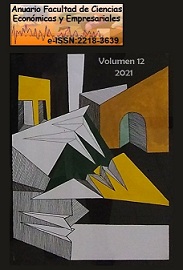Procedure for the design of strategies based on the analysis of critical factors in tourist destinations
Keywords:
tourist destination, Strategy, Impact factors, TourismAbstract
The globalization of the international economy and the development of ICTs have influenced the expansion of the tourism sector as one of the most important economic activities in the last ten years. The optimal management of tourist destinations requires knowing the behavior of the variables in their environment to define strategic projections and manage the possible scenarios of their performance in the medium and long term. The objective of the research is to design a procedure to determine the development strategies of the tourist destination from the impact of the critical factors of the environment by selected key areas. An analysis of primary information was carried out and qualitative and quantitative information search techniques and other tools such as brainstorming, the concept map, the impact importance matrix and structural analysis were applied. The MICMAC software and the SPSS version 15.0 program were used.
References
Bigne, E., Sanchez, I., Sánchez G., J. (2001). Tourism image, evalation variables and aftherpurhasebehaviour: inter-relationship. Tourism Management, 22(6)607-616
Cruz Torres L, González Rodríguez, O, Placeres Hernández, J. F. (2021). La Covid 19 y los nuevos paradigmas para la gestión del turimo en la región Matanzas. Rev Méd Electrón 43(1). Recuperado de http://www.revmedicaelectronica.sld.cu/index.php/rme/article/view/3918/5057
Frías Jiménez, R. A. (2008). Herramientas de apoyo a la solución de problemas no estructurados en empresas turísticas (HASPNET). La Habana: Editorial Universitaria.
Godet, M. (2000). La caja de herramientas de la prospectiva estratégica. Cuaderno No. 5. Recuperado de www.es.laprospective.fr
HIDROAR S.A. (2015). Metodología para el cálculo de matrices ambientales. Recuperado de http://www.ambiente.chubut.gov.ar/wpcontent/uploads/2015/01/Metodolog%C3%ADa- para-el-Calculo-de-las-Matrices-Ambientales.pdf
Manuel, D. L. R. J., Carmen, P. & Xavier, C. (2017). Reglas para ganar en la nueva economía del turismo. Recuperado de htpp://www.hosteltur.com/119986_reglas-ganar-nueva-economia-turismo.html
Morgan, J. C., Cuamea, O., Estrada, A. R. (2020). Las dimensiones teóricas del clúster y su aplicación al turismo médico. Recuperado de https://doi.org/10.20435/inter.v21i3.2255
OMT. (2021). 2020: el peor año de la historia del turismo, con mil millones menos de llegadas internacionales. Recuperado de https://www.unwto.org/es/taxonomy/term/347
Pololikashvili Z. (2019). Panorama del turismo internacional. Madrid: OMT. DOI: https://doi.org/10.18111/9789284421237.
Rivero, A. (2016). Escenarios prospectivos del desarrollo de la Economía Colaborativa en el Destino Turístico Varadero. Recuperado de www.cict.umcc/repositorio/turismo
Vargas, A., Hierro, Ch., Hinojosa, V., Ramón, D., Canalis, X. (2017). Un ‘trumpazo’: El inquilino de la Casa Blanca altera el normal desarrollo de la industria turística. Revista Hosteltur, (4), 5-11.
Published
Issue
Section
License
Copyright (c) 2021 Lázaro Cruz-Torres

This work is licensed under a Creative Commons Attribution-NonCommercial-NoDerivatives 4.0 International License.
Esta revista proporciona un acceso abierto inmediato a su contenido, basado en el principio de que ofrecer al público un acceso libre a las investigaciones ayuda a un mayor intercambio global de conocimiento.
This journal provides immediate open access to its content, based on the principle that providing the public with free access to research supports a greater global exchange of knowledge.



























 Universidad de Oriente
Universidad de Oriente 